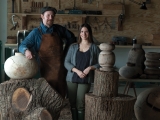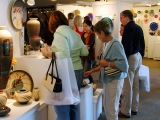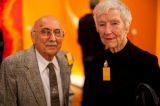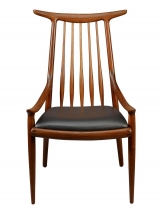
Last spring, I had the pleasure of chatting with furniture maker/designer Vivian Beer about new bodies of work she was developing - immediately followed by the challenge of writing a story that, in effect, was still unfolding.
Now the wait is over. Vivian has unveiled striking new pieces in a solo show at Philadelphia's Wexler Gallery (through Nov. 26), work that carves out a new direction for the talented young artist, including these substantial-but-still-voluptuous ferrocement benches and cornice stools.
"I feel excited about the ability to build form in a new way," she said at a lovely artist's lecture at the Minneapolis College of Art and Design in September. Her interest in industrial infrastructure - highway overpasses, for example - sparked her work in the sandy, steel-mesh-reinforced cement, which then, in turn, influenced the forms of works like Bridge Bench.
"I'm driven by ideology, but I'm also driven by technique; the culture around the technique influences the ideas," she explained. "There is meaning in the way we build things. It reveals our ideologies."
Beer will be giving an artist's talk at Wexler Gallery on October 22, as part of the city-wide DesignPhiladelphia conference, and ...
Black hair has long been a thread in the work of Sonya Clark, as an astute statement of material and cultural otherness. In her latest body of work, hair is both medium and message. Clark applies her material of choice to historically loaded artifacts, in a wrenching intertwining. Hair has a corporeal presence that deepens the impact of the work. As curator Namita Gupta Wiggers says in discussing Black Hair Flag (2010), Clark "deliberately places the ‘body' of black slaves into the history of the Confederacy."
Clark's work is the subject of a solo show now at Snyderman Gallery in Philadelphia through Nov. 19. The show continues at the Southwest School of Art in San Antonio, Texas, on Dec. 8 and continues there until Feb. 12, 2012.
Can't get enough craft? Neither can we. Heck Yes Craft is a series of visual blog posts with a simple mission: to show off amazing work. Come back every Friday for more.
...
This isn't the first time we've been excited about Costantino Nivola. A feature on the artist and his work was included in the January-February 1959 issue of Craft Horizons, five years before he completed the concrete playground we highlight in Crafting Manhattan.
This glimpse of the Sardinian-born artist in his Midcentury heyday shows a man who is working hard to blur the lines between art and architecture in the world he sculpts.
From the article by Dore Ashton:
"The trouble with architecture today," he has said, "is that it lacks the vitalizing touch of the artist. Buildings are made with rulers. So, naturally, a building is a mechanical landscape. But," Nivola adds, "it needn't be. For the touch of the painter or sculptor humanizes a building. The contribution that color and form can make in solving space problems has hardly been explored."
You can download the original article below.
...
Back in April, we published a story about woodworker Joshua Vogel, his partner Kelly Zaneto, and Blackcreek Mercantile & Trading Co., which the couple opened in September 2010 near Kingston, New York. BCM&T's focus is Vogel's turned bowls, vases, and boxes - take a peek at this newly launched catalog of his work - but there are also other goods: handcrafted cutting boards, for example, and a custom-blended cutting board oil.
Now, as BCM&T turns the corner on its first year, The Scout (a lovely and quite craft-minded design/lifestyle site) has given us all a real treat: A fantastic short film about Josh Vogel directed and edited by Brennan Stasiewicz, part of The Scout's documentary series. Just six minutes long, it thoroughly transports you into Vogel's workshop, into the woods - in a word, into his world.
Josh Vogel from The Scout on Vimeo.
...

If you feel a spark in the air, it's because we're in the midst of American Craft Week, which runs through next Sunday, Oct. 16. This is the second year for the nationwide celebration of American craft traditions and innovations. Dozens of galleries, artist studios, festivals, and art institutions are taking part - more than 40 in western North Carolina alone. It's an opportunity to revel in wonderful handmade goods and celebrate the enterprising people who make them.
Find out what's going on in each state by checking the Craft Week website. And if you're near one of these cities, you'll find a bunch of interesting exhibitions, studio tours, artist talks, and other events:
- Ashville, NC
- Charlotte, NC
- New York City
- Birmingham, AL
- Los Angeles
- Boulder, CO
- Washington, DC
- Gainesville, FL
- Atlanta
- Chicago
- Northampton, MA
- Baltimore
- Twin Cities, MN
- St. Louis
On the website, you can learn about opportunities to win gift certificates either for writing an essay ($250) or photographing craft in your daily life ($150). The deadline for both the essay and photo contests is Oct. 21.
American Craft Week is ...

Born in the city of Sarajevo in 1924, now the capital of Bosnia and Herzegovina, Ilana Shafir knew from an early age she was an artist, though her parents were less than enthusiastic. As Shafir remembers, "In those days to be an artist was not a proper career choice for a woman." Her studies at the High School for Architecture were disrupted by the Nazi invasion of 1941. Shafir and her family escaped to the small town of Kula, where they miraculously found protection. No one gave them up, not their neighbors, not the Italian nor even the German soldiers. Shafir painted while in hiding, using old book covers for canvases. She painted landscapes and villagers, and traded her paintings for food. Years later she discovered that both the Italian commander and the local priest had dedicated themselves to saving her family. She insists that "most people, if given the choice, would choose to be kind and humane."
Shafir continued her studies at the Art Academy in Zagreb, Croatia before emigrating in 1949, at the age of 25, to the coastal town of Ashkelon in Israel. She processed the incomprehensible Holocaust and the loss of her extended ...

This is the third in a series of posts about the Getty Institute's Pacific Standard Time initiative by Joyce Lovelace, our L.A. correspondent. Her previous posts were Getty Exhibitions Open, and the Stars Come Out and The House that Sam Built.
Saturday night was the opening of "Golden State of Craft: California 1960 - 1985" at the Craft and Folk Art Museum, which is putting on the exhibition in partnership with Craft in America. This time I brought my son. He's 16 and into sports and guitar, but has a good eye and an open mind. He's at a wonderful age to experience art, and it's fun to see it through his eyes.
L.A.‘s first and only museum devoted exclusively to craft, CAFAM always puts on a great opening party, and this one was extra-festive, packed with distinguished guests. Jo Lauria, curator of "Golden State" (and author of California Design, one of my favorite books). Carol Sauvion, who has worked tirelessly to commemorate our finest makers in her Craft in America documentary series (new episode premieres October 17 on PBS). The famous Claremont potter Harrison McIntosh - he's also in the ...

This is the second in a series of posts about the Getty Institute's Pacific Standard Time by Joyce Lovelace, our L.A. correspondent. Her previous post was Getty Exhibitions Open, and the Stars Come Out.
Sam Maloof was the most famous American woodworker of our time. People who know next to nothing about furniture know his name. The state of California proclaimed him a Living Treasure. Presidents Carter, Reagan, and Clinton all rocked in his chairs. Legend has it Ray Charles ran his hands over a Maloof piece and declared it had soul.
There was more to Maloof's genius, though, than his way with wood. The lyrical title of the Huntington's show has layers of meaning. In a literal sense, "the house that Sam built" was a spectacular, art-filled redwood one in Alta Loma, at the foothills of the San Gabriel Mountains 40 miles east of L.A., where he lived and worked since 1953. But it also refers to the creative community he built around himself through his extraordinary capacity for friendship. Naturally gregarious, Maloof expressed a happy humanity both in his work and in the camaraderie he enjoyed with other ...




